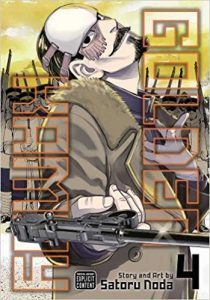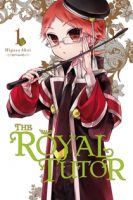Today’s reviews come to you courtesy of Patriot’s Day, my second favorite Massachusetts-only holiday. (The first is Evacuation Day, a thinly-disguised attempt to give Boston’s civil servants permission to skip work on St. Paddy’s.) For your consideration are volume four of D&D cooking extravaganza Delicious in Dungeon, and volumes three and four of everyone’s favorite backwoods culinary adventure Golden Kamuy. Looking back on food manga’s early history in the US, who could have predicted that readers would be feasting on such a wide array of titles in 2018, from Sweetness and Lightning and What Did You Eat Yesterday? to Giant Spider & Me: A Post-Apocalyptic Tale, Food Wars!! Shokugeki no Soma, and Toriko. Maybe the North American market is finally ready for an Iron Wok Jan renaissance…
 Delicious in Dungeon, Vol. 4
Delicious in Dungeon, Vol. 4
Story and Art by Ryoko Kui
Translated by Taylor Engel
Yen Press, 192 pp.
Rated T, for Teens (13+)
If the first volume of Delicious in Dungeon was about assembling a posse, and the second and third about turning monsters into meals, then the fourth is about friendship — specifically, the strong emotional bond between Laois, Marcille, and Falin — and revenge, as the gang finally comes face-to-face with the Red Dragon. The showdown takes place inside a walled city whose narrow, maze-like streets give them a strategic advantage over their Godzilla-sized foe. And as exciting as the fight is, the real payoff is what follows, as Laois and Marcille discover that bringing Falin back from the dead isn’t a simple proposition. It’s in these moments that Ryoko Kui proves a more deft storyteller than we initially realized, effortlessly shifting gears from comedy to drama without mawkishness or cheap jokes. Instead, we’re allowed to contemplate the real horror of being eaten alive — as Falin was — and the real possibility of a character dying for good.
If I’ve made volume four sound like a bummer, rest assured it isn’t. Seshi gets his turn in the spotlight with a weaponized assortment of kitchen tools, while the rest of the gang endures its share of fumbles and miscommunications on the way to catching their dragon adversary. Though I suspect the next volume of Delicious in Dungeon will revert to a monster-of-the-week formula, that’s OK; Kui has firmly established her dramatic and culinary bonafides in volume four, leaving the door open for more character development in the future. Recommended.
 Golden Kamuy, Vols. 3-4
Golden Kamuy, Vols. 3-4
Story and Art by Satoru Noda
Translated by Eiji Yasuda
VIZ Media
Rated M, for Mature (18+)
Midway through volume four of Golden Kamuy, Asirpa builds a fox trap in the woods. “Do foxes taste good?” Sugimoto inquires. “No, not really,” Asirpa replies. “Tanuki have more fat in them and taste a lot better.” With a twinkle in her eye, she then asks, “But Sugimoto, don’t you want to try eating a fox?” A mildly exasperated Sugimoto replies, “You know, I’m not out here to try all the delicacies in Hokkaido.”
There are two ways to read this exchange: as a tacit admission that the cooking elements of Golden Kamuy sometimes occupy more real estate than the battles, or a tacit admission that the series is more compelling as a study of Ainu culture than a bloody frontier adventure. I vote for the second interpretation, as the series’ frequent detours into the food, medicine, and mythology of the Ainu are fascinating, offering a window into a culture that has been largely hidden from Western view. Golden Kamuy is on weaker footing, however, when focusing on its secondary characters and subplots. None of the other gold-seekers are fleshed out as carefully as Asirpa and Sugimoto, despite Satoru Noda’s efforts to give each villain a unique motivation for wanting the treasure. The newest baddie — Kazuo Hemni — exemplifies this problem to a tee: though he’s been given a particularly grisly backstory to explain his murderous proclivities, he’s such a textbook sociopath that he barely rises above the preternaturally-calm-and-savage type.
The art, too, sometimes has a perfunctory quality; in several scenes, Noda’s use of a Photoshopped background doesn’t mesh well with the hand-drawn elements, resulting in an awkward collage. Noda’s use of perspective can also be a distraction. He has difficulty drawing bodies to scale, especially when he’s depicting Asirpa and her family, some of whom look more like Smurfs than people in their head-to-body ratio.
Still, the camaraderie between Asirpa and Sugimoto, and the well-staged action scenes more than compensate for the occasional roughness of the execution or flatness of the characterizations. Golden Kamuy continues to entertain, horrify, and educate in equal measure — something I can’t say for any other manly-man manga that’s currently being published in English. Recommended.



